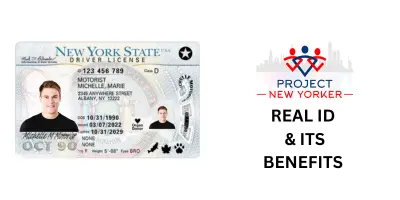What is Real Id: Benefits & Deadlines
Real ID is a new form of identification. It enhances security and authenticity.
Real ID aims to standardize identification across the U. S. It’s essential for air travel and federal building access. Understanding Real ID requirements can be confusing. Each state has different rules and deadlines. In New York, Real ID offers specific benefits and requirements.
Knowing the deadline is crucial to avoid travel issues. Real ID simplifies identity checks, making travel safer. This blog post will explore what Real ID is. We’ll cover its requirements, focus on New York specifics, and discuss the deadline. We’ll also highlight the benefits of having a Real ID. By the end, you’ll have a clear understanding of how Real ID can impact your daily life.

What Is Real Id
The Real ID is a federal initiative aimed at enhancing the security of identification documents. It was created to ensure that driver’s licenses and state IDs meet specific standards. These standards are designed to prevent fraud and improve national security. Real ID is important for access to federal facilities, boarding domestic flights, and entering nuclear power plants. Understanding Real ID requirements and deadlines is crucial for travelers and those accessing certain facilities. In New York, Real ID compliance is a significant issue, with many residents seeking information on what they need to do to obtain a Real ID-compliant document. The benefits of having a Real ID are numerous, including streamlined travel and increased security.
Purpose Of Real Id
Real ID serves a vital role in enhancing the security and integrity of identification documents. Its primary purpose is to establish minimum security standards for state-issued IDs. By meeting these standards, Real ID ensures that IDs are more secure and harder to forge.
- Security Enhancement: Real ID was designed to enhance the security of identification documents.
- Fraud Prevention: It aims to reduce identity fraud by setting stricter requirements for ID issuance.
- Federal Access: Real ID-compliant IDs are required for entering federal facilities and boarding domestic flights.
Real ID compliance involves verifying the applicant’s identity, social security number, and residency. This verification process helps ensure that the ID is issued to the correct person. For many, obtaining a Real ID-compliant document is essential for travel and access to certain facilities. The initiative aims to make identification documents more reliable and trustworthy.
History Of Real Id
The history of Real ID dates back to the aftermath of 9/11. It emerged from a need to improve national security through better identification practices. In 2005, Congress passed the Real ID Act as a response to security concerns highlighted by the attacks.
| Year | Event |
|---|---|
| 2005 | Real ID Act passed by Congress |
| 2013 | Deadline extended for compliance |
| 2023 | Final implementation deadline |
Initially, there was resistance from states regarding implementation. Concerns about cost, privacy, and logistics delayed compliance. Over time, most states adopted Real ID standards. This gradual adoption was critical in ensuring the effectiveness of the Real ID program.
Real ID’s history is marked by challenges and adjustments. Yet, it remains a crucial aspect of national security. Understanding this history helps appreciate the importance and evolution of Real ID standards.
Real Id Requirements
The Real ID Act was passed to enhance security and standardize identification across the United States. It affects how you travel and access federal buildings. Understanding the Real ID requirements is crucial for compliance. This guide helps you navigate the necessary documents and eligibility criteria. Learn what you need for a Real ID in New York, the deadlines, and its benefits.
Documents Needed
To apply for a Real ID, you need specific documents. These verify your identity, residency, and citizenship. Gathering these papers beforehand can save you time at the DMV. Here’s what you’ll need:
- Proof of Identity: A valid passport or birth certificate.
- Proof of Social Security Number: Social Security card or a tax document.
- Proof of Residency: Utility bill or lease agreement with your name and address.
- Name Change Documents: If your name has changed, provide a marriage certificate or court order.
Ensure all documents are originals or certified copies. Photocopies are not accepted. Double-check that your documents are up-to-date and correctly reflect your current information.
Here is a quick reference table for your convenience:
| Document Type | Examples |
|---|---|
| Identity Proof | Passport, Birth Certificate |
| Social Security Number | SSN Card, W-2 |
| Residency Proof | Utility Bill, Lease |
| Name Change | Marriage Certificate, Court Order |
Eligibility Criteria
Not everyone can obtain a Real ID. Certain criteria determine eligibility. It’s important to know if you qualify before applying.
Here are the main eligibility requirements:
- Age Requirement: Applicants must be at least 16 years old.
- Citizenship: You must be a U.S. citizen or permanent resident.
- Residency: Must reside in the state where you apply.
- Document Completeness: All required documents must be complete and accurate.
Each state may have slight variations in their criteria. Check your local DMV for specific details. Being prepared can streamline your application process.
Remember, the Real ID is not mandatory. A passport can still be used for travel. But, having a Real ID simplifies access to domestic flights and federal facilities.
Real Id In New York
The Real ID is a new standard for state-issued identification in the United States, aiming to enhance security and prevent identity fraud. Established by the Real ID Act of 2005, it sets forth requirements that must be met for a driver’s license or ID card to be accepted for federal purposes, like boarding domestic flights or entering certain federal facilities. In New York, obtaining a Real ID is an essential step for residents to ensure compliance before the deadline. The Real ID deadline prompts many to upgrade their existing IDs. New Yorkers should understand the benefits of having a Real ID, which include smoother travel experiences and enhanced security features. The process in New York is straightforward, but requires specific documents and fees.
Application Process
Applying for a Real ID in New York involves several steps. Preparing the required documents is crucial before heading to the Department of Motor Vehicles (DMV). Here’s a simplified guide:
- Proof of Identity: A valid passport or birth certificate.
- Social Security Number: Your Social Security card or a W-2 form.
- Proof of Residency: Utility bills, lease agreements, or mortgage statements.
- Proof of Legal Name Change: If your current name is different from your birth certificate, provide legal documentation.
After gathering these documents, visit a DMV office to submit your application. The process involves submitting your documents, taking a new photo, and paying the necessary fees. It’s wise to book an appointment online to save time.
Here’s a simple table for quick reference:
| Document Type | Examples |
|---|---|
| Identity | Passport, Birth Certificate |
| Social Security | Social Security Card, W-2 Form |
| Residency | Utility Bill, Lease Agreement |
| Name Change | Marriage Certificate, Court Order |
Cost Of Real Id
The cost of obtaining a Real ID in New York is similar to renewing a standard driver’s license. Fees vary based on several factors, including the type of ID and the duration of its validity. Generally, it ranges from $64.50 to $80.00.
Here’s what you need to know about the costs:
- Driver’s License Renewal: Approximately $64.50.
- Enhanced ID or License: Around $80.00.
- Additional Fees: Some counties may impose extra charges.
Payment methods accepted at the DMV include cash, credit/debit cards, and checks. Remember to bring the correct amount to avoid delays. Budgeting for these costs is essential as deadlines approach. A Real ID offers benefits that make the investment worthwhile, such as easier travel and improved security.
Real Id Deadlines
The Real ID Act sets standards for issuing secure driver’s licenses and ID cards. It ensures these IDs can be used for federal purposes, such as boarding domestic flights and entering federal facilities. Understanding Real ID deadlines is crucial. These deadlines impact when you need a compliant ID to travel or access certain places. The Real ID deadlines vary. There’s a national deadline and individual state-specific deadlines. Knowing these timelines helps avoid last-minute stress and ensures you have the required ID when needed.
National Deadline
The national deadline for Real ID compliance is set for May 7, 2025. After this date, federal agencies will only accept Real ID-compliant licenses and ID cards for official purposes. It’s important to prepare ahead. Here’s what you need to know:
- Domestic Flights: You will need a Real ID to board domestic flights within the United States.
- Federal Buildings: Access to federal buildings and facilities will require a Real ID-compliant card.
- Military Bases: Entry will require a compliant ID post-deadline.
Missing the national deadline means you might face travel interruptions. If your current ID isn’t compliant, consider applying for a Real ID at your local DMV. Gather necessary documents early, including proof of identity, social security number, and residency. Ensure your documents are current and correct. Avoid delays by planning ahead.
State-specific Deadlines
While the national deadline is uniform, each state has its own timeline for issuing Real IDs. States have been rolling out Real ID-compliant licenses since the law’s enactment. Understanding your state’s specific deadlines is key:
| State | Deadline |
|---|---|
| New York | Currently issuing; align with national deadline |
| California | Currently issuing; align with national deadline |
| Texas | Currently issuing; align with national deadline |
State-specific deadlines can vary in terms of when Real IDs become available. Some states already issue compliant IDs, aligning with the national deadline. New York, for example, is actively issuing Real IDs. Confirm with your state’s Department of Motor Vehicles for updates. Check local DMV websites for specific state-related details. Knowing your state’s timeline prevents unforeseen issues. Being informed ensures compliance and smooth transitions.

Credit: www.syracuse.com
Benefits Of Real Id
The Real ID is a nationwide initiative designed to enhance security. It standardizes identification requirements across states, ensuring safer and more reliable ID cards for citizens. Real ID requirements include stringent verification processes, such as providing proof of identity and residency. In New York, residents need to present specific documents at DMV offices to receive their Real ID. The deadline for obtaining a Real ID varies by state, but it is essential to meet this requirement to access certain services. One major advantage of having a Real ID is the array of benefits it offers, particularly in terms of traveling and accessing federal facilities.
Traveling With Real Id
Real ID transforms travel experiences. It serves as a recognized form of identification at airports across the United States. This means you can pass through security checkpoints more smoothly. No more fumbling for additional forms of identification. With Real ID, you have a single document that proves your identity and residency.
- Ease of Airport Security: Real ID is accepted at TSA checkpoints, eliminating the need for a passport for domestic flights.
- International Travel: Though Real ID is not a substitute for a passport, it helps streamline processes when transitioning between domestic and international flights.
Traveling with a Real ID ensures compliance with federal regulations. It reduces the risk of being denied boarding on domestic flights. It’s particularly beneficial for frequent travelers. No need to worry about carrying multiple IDs or passports.
| Benefit | Description |
|---|---|
| Streamlined Identification | Single ID for domestic travel. |
| Federal Compliance | Meets TSA requirements. |
Accessing Federal Facilities
Having a Real ID is not just useful for travel. It opens doors to federal facilities. Whether visiting a courthouse or a military base, Real ID is your ticket to access. It complies with federal standards, ensuring your ID is recognized.
- Easy Access: Real ID enables entry into federal buildings without the need for additional identification.
- Security Assurance: It provides security personnel a verified ID, speeding up the entry process.
Real ID is more than an ID. It’s a proof of identity that is trusted nationwide. This trust means fewer hassles. Less time spent verifying your identity. More time focused on the purpose of your visit.
With Real ID, you also enjoy peace of mind. Knowing that your ID meets federal standards. Knowing that your access to federal facilities is guaranteed. It’s an essential tool for anyone needing regular access to these areas.
Differences From Standard Id
The Real ID is a special type of identification that meets federal security standards. It was created to make identification more secure and to prevent fraud. To get a Real ID, you must show certain documents like proof of identity, social security number, and residency. In New York, the Real ID follows the same rules as in other states. The deadline to obtain a Real ID varies, so it’s important to check the latest information. Having a Real ID offers benefits such as easier access to federal facilities and domestic flights. Let’s explore how a Real ID differs from a standard ID.
Security Features
The Real ID comes with enhanced security features that make it more reliable than a standard ID. These features are designed to prevent counterfeiting and misuse. Some key security features include:
- Holographic Images: These are visible when the ID is tilted under light, making it difficult to replicate.
- Microprinting: Tiny text that is hard to read with the naked eye but visible under magnification.
- Optical Variable Inks: Inks that change color when viewed from different angles.
- Barcodes: Contain encrypted information about the cardholder.
These features ensure that Real IDs are much harder to forge. This protects your identity and personal information. The Real ID Act requires these enhancements to improve security.
Here’s a quick comparison between a Real ID and a standard ID:
| Feature | Real ID | Standard ID |
|---|---|---|
| Holographic Images | Yes | No |
| Microprinting | Yes | No |
| Optical Variable Inks | Yes | No |
| Barcodes | Encrypted | Basic |
Identification Uses
A Real ID serves more purposes than a standard ID. It is accepted in more places and allows for more secure transactions. Here are some key identification uses:
- Domestic Flights: Starting from the deadline, a Real ID is required to board domestic flights.
- Federal Facilities: Access to federal buildings requires a Real ID. This includes military bases and other secure locations.
- Enhanced Security: Real ID offers better protection of your personal details in various settings.
- State Identification: It can be used as a regular state ID in most situations, like buying age-restricted items.
While a standard ID may suffice for some local uses, a Real ID is necessary for federal purposes. This makes it a vital document for frequent travelers and those needing access to federal facilities.
Understanding these differences helps in deciding whether to upgrade your standard ID to a Real ID. It offers peace of mind and convenience for secure identification.
How To Apply For Real Id
The Real ID is a new form of identification that meets federal security standards for state-issued driver’s licenses and ID cards. To enhance safety, the Real ID Act was established to improve the reliability of state-issued IDs. To get a Real ID, you must meet specific requirements, such as proving your identity and residency. New York residents can apply for a Real ID at their local Department of Motor Vehicles (DMV). The deadline to obtain a Real ID is approaching soon, so it’s crucial to understand the process. Having a Real ID offers several benefits, including the ability to board domestic flights and access certain federal buildings. Let’s explore how to apply for a Real ID.
Online Application
Applying for a Real ID online can save time and effort. While not all aspects can be completed online, starting the process digitally is efficient. Here’s how to begin:
- Check Eligibility: Confirm that your state allows online applications for a Real ID.
- Visit the Official Website: Go to your state DMV’s website and locate the Real ID application section.
- Create an Account: Register or log in to your DMV account to start the application process.
- Fill Out the Form: Complete the online application form with your personal details.
- Upload Documents: Prepare digital copies of required documents such as proof of identity, Social Security number, and residency. Upload these to the website.
- Schedule an Appointment: Choose a date and time for your in-person visit to complete the process.
Ensure that all information is accurate to avoid delays. Although the online process simplifies application, an in-person visit is still necessary to verify documents.
In-person Steps
Completing your Real ID application involves an in-person visit to the DMV. This step verifies your documents and identity. Here’s what to expect:
- Gather Documents: Bring original copies of your identification documents. These include a birth certificate, Social Security card, and proof of residency.
- Visit the DMV: Arrive at the DMV with your documents. Ensure you have an appointment if required.
- Submit Application: Hand over your completed application form along with your documents to the DMV clerk.
- Photo and Fingerprint: Be prepared to have your photo taken and fingerprint scanned.
- Pay the Fee: A fee is required for processing your Real ID. Payment methods may vary by location.
- Receive Your Real ID: Once approved, your Real ID will be mailed to you. Processing times may vary.
Ensure your visit is smooth by double-checking your document list. Missing or incorrect documents can delay the process. Keep in mind that the Real ID is not mandatory, but it will be essential for certain activities like flying domestically.
Common Myths About Real Id
The Real ID Act has stirred quite a bit of conversation. It’s a law that sets new standards for issuing driver’s licenses and ID cards. Many states are working to comply with these standards, including New York. The deadline for getting a Real ID is approaching, and people are eager to understand its benefits. But along with the facts, myths have emerged. These myths confuse many individuals who want to know what the Real ID really is. Let’s explore some common misconceptions and clarify the facts.
Misconceptions
There are several misconceptions surrounding the Real ID. Some believe that it’s a national ID card, while others think it’s mandatory for everyone. Both notions are incorrect. Here are some myths to be aware of:
- National ID Card: Many people think Real ID is a national ID. In reality, it’s a state-issued license that meets federal standards.
- Mandatory for All: Some say you must have a Real ID by the deadline. However, it’s not compulsory unless you plan to fly domestically or enter federal facilities.
- Costly Upgrade: People often worry about high costs. The fee for Real ID is usually similar to a standard license renewal.
- Privacy Concerns: There’s fear of losing privacy. Real ID has no tracking chips or GPS features.
Understanding these myths helps clear confusion and assists in making informed decisions. Real ID is simply a more secure form of identification.
Clarifying Facts
Clearing up the myths is crucial for understanding the Real ID. Let’s look at the facts:
- State-Issued ID: Real ID is issued by states, not the federal government. It adheres to federal standards for enhanced security.
- Optional for Non-Flyers: If you don’t fly or visit federal buildings, a Real ID isn’t necessary. You can use your passport or other forms of ID instead.
- Comparable Costs: The cost of obtaining a Real ID is typically on par with renewing a standard driver’s license. Check with your state for exact fees.
- Secure Data Handling: Real ID does not store personal data differently than regular licenses. It ensures your identity is verified through secure processes.
These facts help clarify what Real ID truly entails. Knowing the truth empowers individuals to decide if Real ID is right for them. With the deadline nearing, understanding these aspects is more important than ever.
Frequently Asked Questions
Can You Travel Without A Real Id After May 2025?
You need a REAL ID or a valid passport to fly domestically in the U. S. after May 2025. Non-compliant IDs will not be accepted for air travel. Ensure your identification meets the requirements to avoid any travel disruptions. Check with the TSA for updated guidelines and accepted documents.
What Documents Do I Need For A Real Id In Ny?
To get a REAL ID in NY, bring proof of identity, Social Security number, residency, and U. S. citizenship or lawful status. Acceptable documents include a passport, Social Security card, and utility bill. Check the NY DMV website for a complete list of acceptable documents and requirements.
What Happens If You Don’t Have A Real Id By May 7?
Without a REAL ID by May 7, you can’t fly domestically or access federal facilities. A valid passport or other TSA-approved ID is needed for air travel. Renew or upgrade your driver’s license to avoid travel disruptions. Plan ahead to ensure compliance with security requirements.
What Is The Difference Between Enhanced Id And Real Id In Ny?
Enhanced ID allows land border crossings to Canada, Mexico, and some Caribbean countries. REAL ID is for domestic flights and federal facilities. Both require proof of identity and residency. Enhanced ID costs more but provides additional travel benefits. Both are available at New York DMV offices.
Conclusion
Real ID ensures safer and more secure identification for everyone. Meeting the requirements is crucial. Especially for travel and accessing federal facilities. New York residents should prepare now. The deadline is approaching fast, so don’t delay. Benefits of having a Real ID include ease of travel and added security.
It’s a step towards a safer future. Understanding the process helps you stay compliant. Stay informed, and make sure you’re ready. Real ID simplifies identification while enhancing safety. It’s an important update for all citizens. Prepare today and enjoy peace of mind tomorrow.



